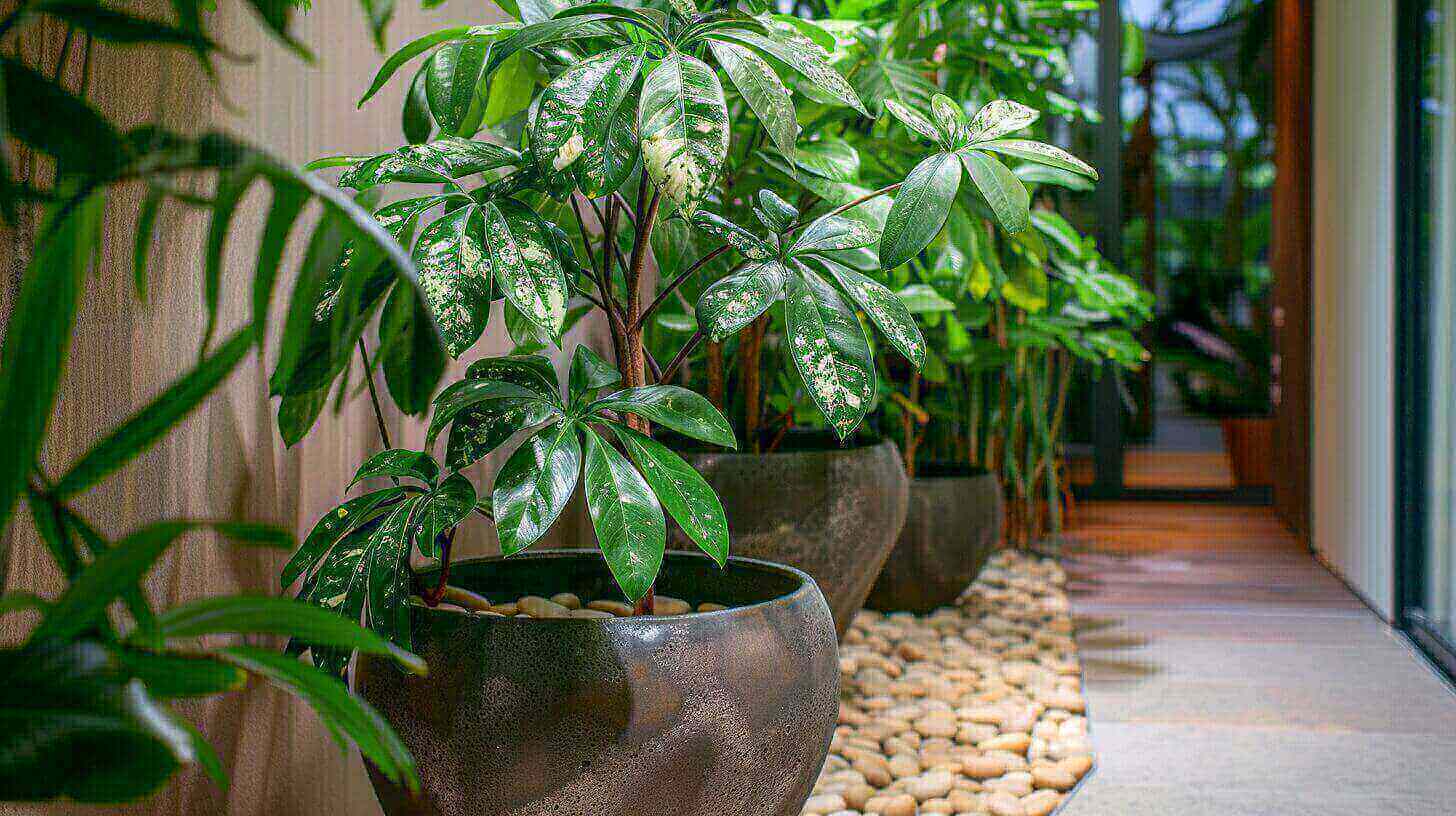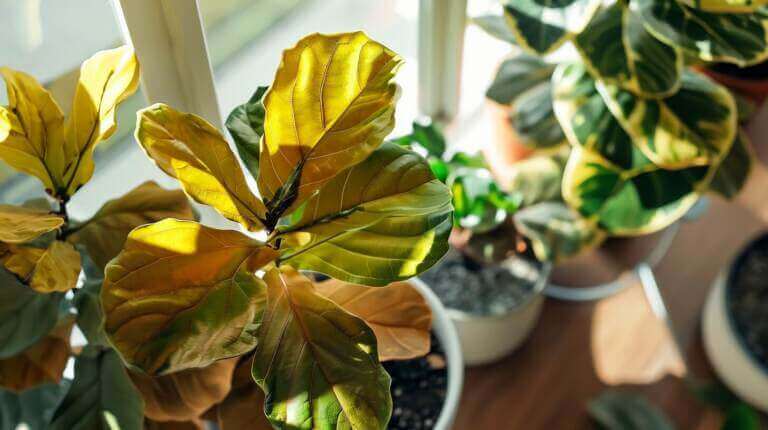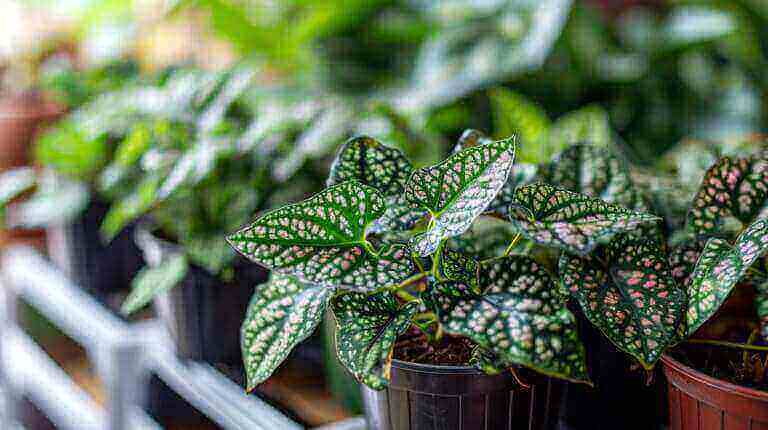What to Do When Your Schefflera Umbrella Plant Gets Leggy or Droopy
Is your umbrella plant looking a bit leggy or droopy? Don’t worry, it’s a common issue that can be easily fixed with a few simple steps. In this article, I will guide you through the causes of leggy umbrella plants and provide solutions to bring back the bushiness and health of your schefflera.
Key Takeaways
- Leggy umbrella plants can be caused by factors such as older plants shedding leaves, temperature extremes, and insufficient light.
- To fix a leggy schefflera, you can propagate by air-layering or prune to encourage new growth and bushiness.
- Increasing light and humidity by placing the plant outdoors during summer can promote healthier growth.
- Adequate light is crucial for the health and growth of umbrella plants. Bright indirect light is preferred, while direct sun should be avoided.
- Pruning is an effective technique to address leggy umbrella plants. Trim the leggy stems to encourage new branches and improve the plant’s shape.
Causes of Leggy Umbrella Plants
Leggy umbrella plants can be caused by various factors. Older plants are more prone to shedding leaves, starting from the bottom and leaving the lower stems bare. Sudden shifts in temperature, such as hot or cold drafts, can also trigger leaf drop. Keeping the plant too dry or too wet can lead to foliage loss. Insufficient light can make the plant appear less full, while too much direct sun should be avoided. It’s important to understand the specific causes in order to effectively address the issue.
Factors That Contribute to Legginess
“Older umbrella plants naturally shed mature leaves, which can result in a leggy appearance as the lower stems become exposed,” explains gardening expert Jane Baker. “Temperature extremes, like drafts or sudden changes in the environment, can cause leaves to drop, leaving the plant looking sparse. Additionally, overwatering or underwatering can lead to leaf loss and a leggy appearance. Finally, insufficient light can prevent proper foliage growth and result in a less full-looking plant.”
The Impact of Light on Umbrella Plants
Light plays a significant role in the growth and development of umbrella plants. If the plant receives inadequate light, it may exhibit few leaves spaced far apart along the stem, contributing to the leggy appearance. Umbrella plants thrive in bright indirect light, making them ideal for placement near windows with filtered sunlight. While some direct sun exposure is acceptable, it’s important to avoid full sun, as it can be too intense for the plant. A lack of sufficient light will impede the plant’s ability to grow dense and may cause it to appear less full. Providing the right amount of light is key to maintaining a lush and vibrant umbrella plant.
Optimal Conditions for Healthy Umbrella Plants
- Keep older plants away from drafts and maintain a consistent temperature.
- Water the plant when the top layer of soil is dry, but avoid overwatering.
- Provide bright indirect light, avoiding full sun exposure.
- Ensure proper humidity levels by misting the plant or using a humidifier.
- Regularly fertilize the plant with a balanced houseplant fertilizer.
| Cause | Symptoms | Solutions |
|---|---|---|
| Older plant shedding mature leaves | Bare lower stems, sparse foliage | Pruning to stimulate new growth, increase light |
| Temperature extremes | Leaf drop | Avoid drafts, maintain consistent temperature |
| Dry conditions | Foliage loss | Water appropriately, allowing top layer of soil to dry out between waterings |
| Wet conditions | Foliage loss | Avoid overwatering, ensure proper drainage |
| Insufficient light | Less full appearance | Provide bright indirect light, avoid direct sun |
Fixing Leggy Schefflera Plants
If you’re dealing with a leggy schefflera plant, don’t worry – there are ways to fix it and restore its bushiness. Two effective methods are air-layering and pruning.
Air-layering
Air-layering is a propagation technique that allows you to fix a leggy schefflera plant and create new individual plants at the same time. To do this, choose a healthy stem and make a small cut about halfway through the stem, just below a node. Place damp sphagnum moss around the cut area and wrap it with plastic wrap to hold the moisture in. After a few weeks, roots will form, and you can cut the stem below the root ball and pot it as a new plant. This method promotes new growth and helps the parent plant become bushier.
Pruning
Pruning is another effective way to fix a leggy schefflera plant. Identify the leggiest stems, and using clean, sharp pruners, trim the tops about an inch above a leaf node. This practice encourages new branches to grow from those areas, making the plant bushier. Don’t be afraid to prune severely if necessary, as schefflera plants respond well to pruning and can quickly recover and become more compact.
Placing your schefflera plant outdoors during the summer months can also stimulate growth and improve its overall appearance. Just be sure to gradually acclimate it to the outdoor conditions to prevent stress or damage.
Summary
- Air-layering is a propagation technique that allows you to fix a leggy schefflera plant and create new plants.
- Pruning is an effective method to fix a leggy schefflera plant. Trim the leggiest stems to encourage new growth.
- Placing the plant outdoors during summer can stimulate growth and improve its overall appearance.
Importance of Light for Healthy Umbrella Plants
If you want to keep your umbrella plant (schefflera) healthy and vibrant, providing adequate light is essential. Light plays a crucial role in the growth and overall well-being of this plant. Insufficient light can result in leggy growth, where the plant becomes tall and sparsely leafed. To ensure optimal growth and a lush appearance, it’s important to understand the importance of light and how to provide the right conditions for your schefflera.
Umbrella plants prefer bright indirect light, which means placing them near a window with filtered sunlight is ideal. This allows the plant to receive the necessary amount of light without direct exposure to harsh rays. Direct sun should be avoided as it can scorch the leaves and cause damage to the plant. In a dark location with limited light, the umbrella plant may not grow densely and may appear less vibrant and healthy.
To provide the optimal light conditions for your umbrella plant, observe its natural habitat in the wild. Schefflera plants are native to tropical regions where they grow under the shade of taller trees. Mimicking this environment with bright indirect light will promote healthy growth and prevent legginess. It’s important to strike a balance, as too much light can also be detrimental to the plant’s well-being.
Key points to remember:
- Umbrella plants require bright indirect light for healthy growth.
- Avoid direct sun exposure, as it can cause leaf damage.
- Mimic the natural environment of the plant by providing filtered sunlight.
- Too little or too much light can result in leggy growth or stunted development.
| Light Conditions | Growth and Appearance |
|---|---|
| Bright Indirect Light | Lush, healthy, and vibrant growth |
| Direct Sunlight | Leaf burn and damage |
| Insufficient Light | Leggy growth and sparse foliage |
| Too much Light | Stunted growth or leaf discoloration |
Pruning Techniques for Leggy Umbrella Plants
If your umbrella plant has become leggy and you want to restore its compact and bushy appearance, pruning is an effective solution. By selectively trimming the leggy stems, you can encourage new growth and the development of outward-growing branches, improving the overall shape of the plant.
To begin pruning your leggy umbrella plant, start by identifying the stems that are the most leggy and sparse. These are the areas that will benefit the most from pruning. Using clean and sharp pruning shears, trim the tops of the leggy stems about an inch above a leaf node. This strategic pruning technique stimulates the growth of new branches from those areas, resulting in a fuller and more attractive plant.
When pruning, don’t be afraid to be bold. Umbrella plants respond well to pruning and can quickly recover and become bushier. If necessary, you can even prune severely to achieve the desired shape and density. Remember to prune evenly throughout the plant to maintain a balanced and symmetrical appearance.
Pruning Tips for Umbrella Plants:
- Identify the leggiest stems and target those areas for pruning.
- Use clean and sharp pruning shears to make precise cuts.
- Trim the tops of the leggy stems about an inch above a leaf node.
- Prune evenly throughout the plant to maintain balance.
- Don’t be afraid to prune severely if necessary.
Pruning not only improves the appearance of your leggy umbrella plant, but it also promotes healthier growth and rejuvenation. With proper pruning and care, your umbrella plant will thrive and regain its lush and vibrant foliage.
Care Tips for Preventing Legginess in Umbrella Plants
When it comes to keeping your umbrella plant (schefflera) healthy and preventing legginess, there are a few key care tips to keep in mind. Providing the right conditions for optimal growth is essential.
1. Light: Place your umbrella plant near a window that receives filtered sunlight. This will ensure that it gets the right amount of light it needs to thrive. Avoid placing it in direct sunlight, as this can lead to leaf burn.
2. Water: It’s important to water your umbrella plant appropriately. Allow the top layer of soil to dry out before watering again. Overwatering can lead to root rot, while underwatering can cause the plant to become stressed and more prone to legginess.
3. Fertilizer: Regularly fertilize your umbrella plant to provide it with the necessary nutrients for healthy growth. Use a balanced houseplant fertilizer and follow the instructions on the packaging for proper application.
4. Repot: If your umbrella plant outgrows its current pot, it’s time to repot it into a slightly larger container. This will give the plant more room to grow and prevent it from becoming root-bound. Use a well-draining soil mix suitable for houseplants.
5. Support: As your umbrella plant matures, it may need some support to maintain an upright growth habit. Consider using stakes or a plant support to keep the stems from becoming too leggy and to help it grow in a more compact and bushy shape.
FAQ
What causes a schefflera plant to become leggy?
Schefflera plants can become leggy due to natural leaf shedding, temperature extremes, dry or wet conditions, and insufficient light.
How can I fix a leggy schefflera plant?
You can fix a leggy schefflera plant by propagating through air-layering or pruning to encourage new growth and bushiness. Increasing light and humidity can also promote healthier growth.
What can cause an umbrella plant to become leggy?
Legginess in umbrella plants can be caused by older plants shedding leaves, temperature fluctuations, and improper watering.
How can I propagate a leggy schefflera plant?
You can propagate a leggy schefflera plant by air-layering, which involves rooting a cutting while it is still attached to the parent plant and then potting it up as a new plant.
How can I prune a leggy umbrella plant?
To prune a leggy umbrella plant, identify the leggiest stems and trim them about an inch above a leaf node. This will encourage new branches to grow and make the plant bushier.
How can I prevent my umbrella plant from becoming leggy?
To prevent legginess in an umbrella plant, provide adequate light, water appropriately, fertilize regularly, repot when necessary, and provide support for older plants.







